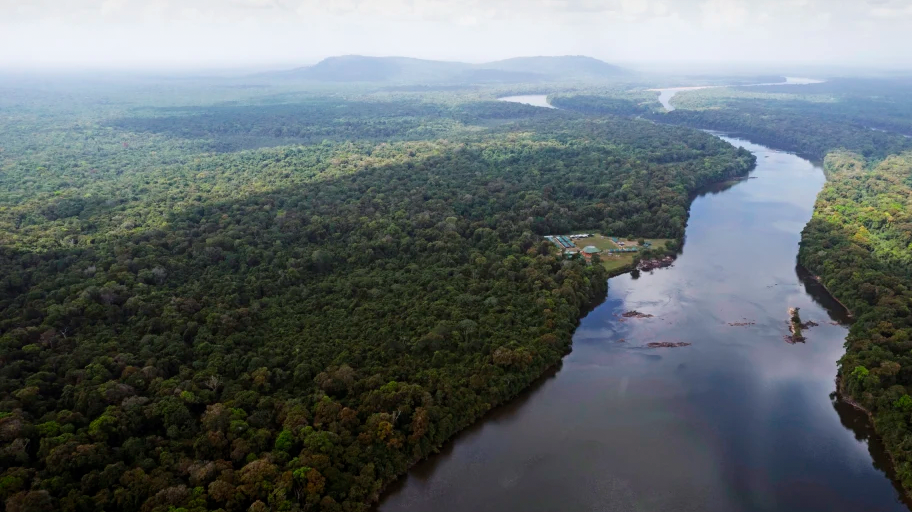 The Essequibo River flows through Kurupukari crossing in Guyana. The boundary was drawn by an international commission back in 1899, which Guyana argues is legal and binding, while Venezuela is disputing it. The U.S., meanwhile, is interfering on behalf of oil interests. | Juan Pablo Arraez / AP
The Essequibo River flows through Kurupukari crossing in Guyana. The boundary was drawn by an international commission back in 1899, which Guyana argues is legal and binding, while Venezuela is disputing it. The U.S., meanwhile, is interfering on behalf of oil interests. | Juan Pablo Arraez / AP
Venezuelan President Nicolás Maduro warned recently that “the Southern Command is provoking our region…[as it] tries to set up U.S. military bases in our Essequibo Guyana.” Venezuelan diplomat José Silva Aponte earlier had observed that “the United States is intent upon both countries arriving at confrontation.”
Dispute between Venezuela and Guyana over the Essequibo district originated in the early 19th century as Venezuela defied British Guinea in claiming jurisdiction over Essequibo. That territory borders on Venezuela’s eastern frontier and accounts for two-thirds of Guyana’s land mass. British Guinea became Guyana in 1966 with the end of British colonialism.
An arbitration tribunal in Paris rejected Venezuela’s claim in 1899. Venezuela and the newly independent Guyana agreed in 1966 that the earlier decision was unfounded and that negotiations would continue. The case remains in limbo; the International Court of Justice is involved.
The U.S. government has taken Guyana’s side—no surprise in that Exxon Mobil Corporation is well ensconced there. Oil discovered in 2015 has Guyana, including Essequibo, on track to soon become the world’s fourth-largest offshore oil producer.
Venezuela’s government in 2023 created a “Zone of Comprehensive Defense of Guyanese Essequibo.” It’s made plans for the “exploration and exploitation of oil, gas, and minerals” in the region. Venezuelans voting on Dec. 3, 2023, overwhelmingly approved a referendum allowing their government to establish sovereignty over the contested territory. Essequibo would become a new Venezuelan state.
CIA head William Burns visited Guyana in March 2024. Reacting, Venezuela’s vice president Delcy Rodríguez explained, “In the history of this U.S. intelligence agency, there is not a single positive milestone; but only death, violence and destruction.” Foreign minister Yvan Gil condemned the visit as “an escalation of provocations against our country and meddling, together with the U.S. Southern Command.”
U.S. resort to military power via the Southern Command suggests that powerbrokers in Washington see the possibility of accomplishing two missions with the same stroke. They want Essequibo to remain within the orbit of Guyana and Exxon Mobil. And, having found a pretext for introducing military power, they would be moving toward the forced removal of a despised left-leaning government.
The Southern Command is responsible for U.S. military operations and “security cooperation” throughout Latin America and the Caribbean.
The Guyana media follows local U.S. military activities. Reporting on December 1, Bernardo de la Fuente detailed Southern Command assistance to the Guyanese Defense Force (GDF). It includes:
- The upgrading of four Coast Guard River stations, plus additions to the port structure at the Ramp Road Ruimveldt Naval Station in Georgetown.
- Constructing an outboard motor boat launching ramp and interceptor boat storage yard at a naval facility.
- Supplying U.S.-constructed “Metal Shark Defiant” patrol boats.
- Refurbishing a naval headquarters, constructing a new hangar, and “expanding the existing facilities of the Air Wing of the Defense Force”
- Developing “a network of radio repeater stations and a Jungle Amphibious Training School.”
The Southern Command is “helping the GDF strengthen its technological capabilities, as well as directly supporting strategic planning, policy development and coordination of military and security cooperation to strengthen the interoperability of its services in the face of new threats.”
The rehabilitation of a jungle airstrip in Essequibo is icing on the cake. For $688 million, the now fully-fledged airfield has been extended to 2,100 feet; it will “withstand all weather conditions and ensure 24-hour accessibility.” According to reporter Sharda Bacchus, the GDF provided $214.5 million. The U.S. taxpayer presumably supplies the rest.
Bernardo de la Fuente notes the airfield’s location adjacent to the west-to-east running Cuyuni River. For Guyana, but not for Venezuelans, that river marks the northern border of both Guyana and Essequibo and the southern border of eastern Venezuela.
Immediate across the river, on the Venezuela side, construction is underway of a jungle command school, ambulatory medical center, training field, and more. Venezuelan General Elio Estrada Paredes and colleagues arrived on Dec. 6 for an inspection visit. A refurbished airstrip provides access to the area.
Officials in Washington have long sought to destroy a Venezuelan government that offends in two ways. It exerts control over huge oil reserves and has aspired to be a model for people-centered political change. Governments led by Presidents Chávez and Maduro, after Chávez died in 2013, have had to contend with multiple U.S. intrusions.
They include: an unsuccessful coup in 2002 facilitated by the State Department, tens of millions of dollars delivered to dissident groups, painful economic sanctions from 2015 on, U.S. backing for a puppet Venezuelan president, and the stealing of Venezuelan assets located abroad. U.S. military interventions have been trivial. There was the tiny, U.S.-led seaborne invasion in 2020 (“Operation Gideon”). U.S.-allied Colombian paramilitaries cause mischief inside Venezuela. The U.S. Navy’s Fourth Fleet monitors air and sea approaches to Venezuela.
A U.S. turn to military force directed at Venezuela may not elicit the criticism from U.S. progressives that might have obtained during the Chávez era. Their attachment to Venezuela’s Bolivarian project appears to have weakened.
President Maduro shows less charisma than President Chávez; he does not match Chávez’s personification of the cause of regional unity, of “Our America.” According to Venezuela’s Communist Party, his government in 2018 “flattened the wages for all sectors and unilaterally canceled all the collective bargaining agreements of…workers.” It later “strengthened its alliance with sectors of big capital, particularly the new bourgeoisie.”
Controversy surrounding Maduro’s re-election to office on July 28, 2024 centers on incomplete reporting of voting tallies. Gustavo Petro, Colombia’s first-ever progressive president, expressed skepticism at the election results. Alleging over-dependence on oil exports for the financing of development, Petro claimed on Dec. 5 that “Venezuelans now don’t know if they are a democracy, or if they have a revolution.”
The Maduro government recently excluded Venezuela’s Communist Party (PCV) from effective electoral participation, perhaps to gain favor in Washington.
Some U.S. progressives disenchanted with the Maduro government may be unaware of its achievement of having built urban and rural communes. They may not have adequately factored in heavy U.S. funding of a divided opposition or recent destabilization inside Venezuela caused by Colombian paramilitaries.
Anti-imperialists may find that assessing the virtues and shortcomings of U.S.-targeted governments doesn’t work well as guidance for action. They might recall their primary vocation of opposition to capitalism.
They would surely derive ample inspiration from there to oppose maneuvering in defense of Exxon Mobil in Essequibo—and enough too to reject U.S. military meddling, whether in a dispute between two nations or against Venezuela itself.
As with all news-analytical articles published by People’s World, the views expressed here are those of the author.
We hope you appreciated this article. At People’s World, we believe news and information should be free and accessible to all, but we need your help. Our journalism is free of corporate influence and paywalls because we are totally reader-supported. Only you, our readers and supporters, make this possible. If you enjoy reading People’s World and the stories we bring you, please support our work by donating or becoming a monthly sustainer today. Thank you!
Tags:



